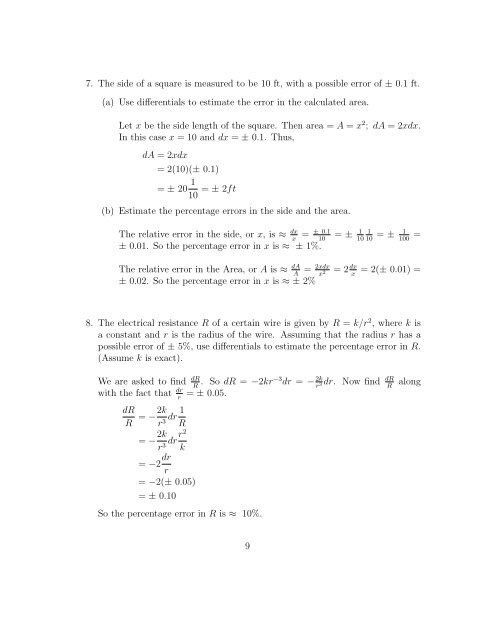Local Linear Approximation; Differentials Solutions To Selected ...
Local Linear Approximation; Differentials Solutions To Selected ...
Local Linear Approximation; Differentials Solutions To Selected ...
You also want an ePaper? Increase the reach of your titles
YUMPU automatically turns print PDFs into web optimized ePapers that Google loves.
7. The side of a square is measured to be 10 ft, with a possible error of ± 0.1 ft.<br />
(a) Use differentials to estimate the error in the calculated area.<br />
Let x be the side length of the square. Then area = A = x 2 ; dA = 2xdx.<br />
In this case x = 10 and dx = ± 0.1. Thus,<br />
dA = 2xdx<br />
= 2(10)(± 0.1)<br />
= ± 20 1<br />
= ± 2ft<br />
10<br />
(b) Estimate the percentage errors in the side and the area.<br />
The relative error in the side, or x, is ≈ dx<br />
x<br />
± 0.01. So the percentage error in x is ≈ ± 1%.<br />
± 0.1 = 10<br />
The relative error in the Area, or A is ≈ dA 2xdx = A x2 ± 0.02. So the percentage error in x is ≈ ± 2%<br />
= ± 1<br />
= 2 dx<br />
x<br />
1<br />
10 10<br />
= ± 1<br />
100 =<br />
= 2(± 0.01) =<br />
8. The electrical resistance R of a certain wire is given by R = k/r 2 , where k is<br />
a constant and r is the radius of the wire. Assuming that the radius r has a<br />
possible error of ± 5%, use differentials to estimate the percentage error in R.<br />
(Assume k is exact).<br />
We are asked to find dR<br />
R . So dR = −2kr−3dr = − 2k<br />
r3 dr. Now find dR<br />
R along<br />
= ± 0.05.<br />
with the fact that dr<br />
r<br />
dR<br />
R<br />
1<br />
= −2k dr<br />
r3 R<br />
= − 2k r2<br />
dr<br />
r3 k<br />
= −2 dr<br />
r<br />
= −2(± 0.05)<br />
= ± 0.10<br />
So the percentage error in R is ≈ 10%.<br />
9

















